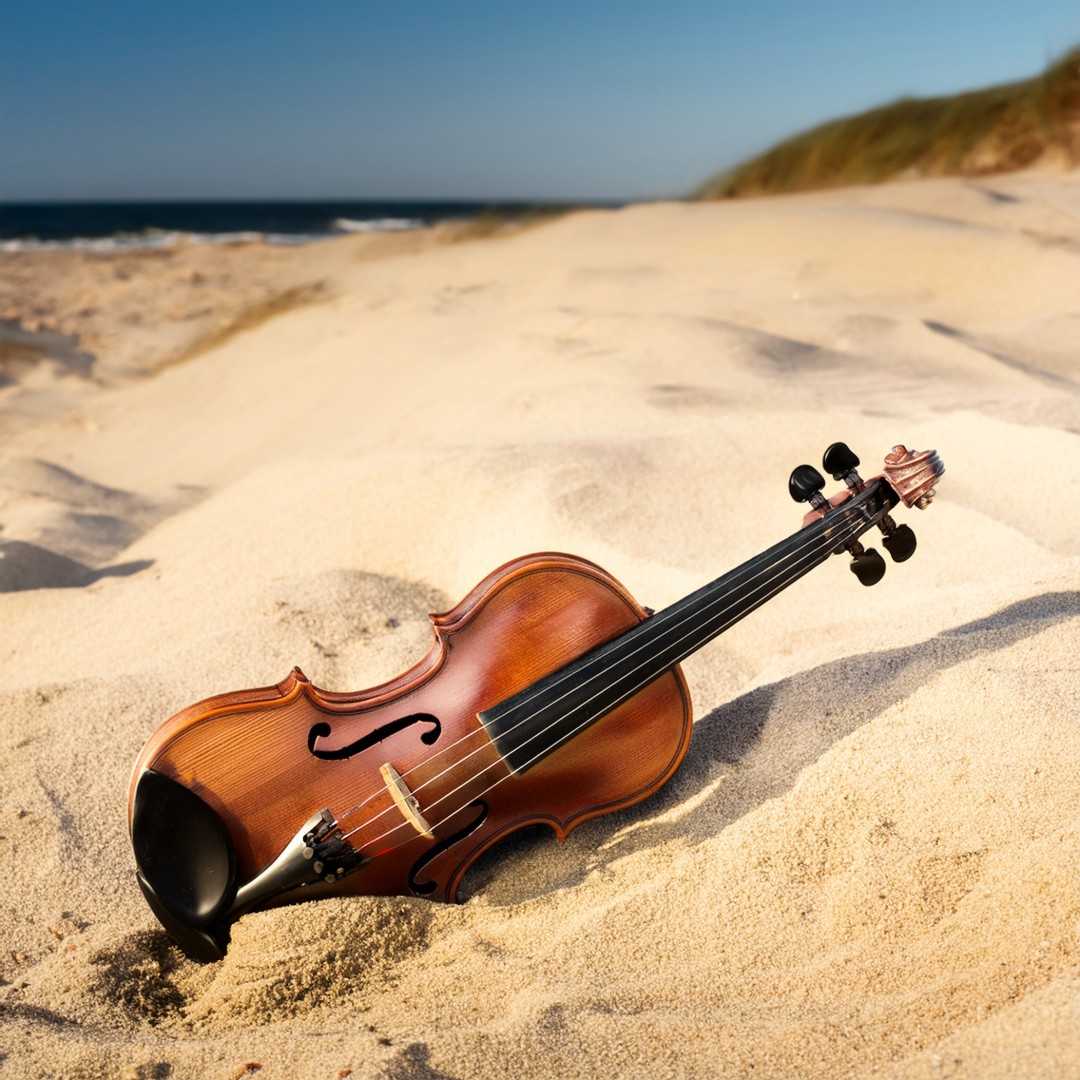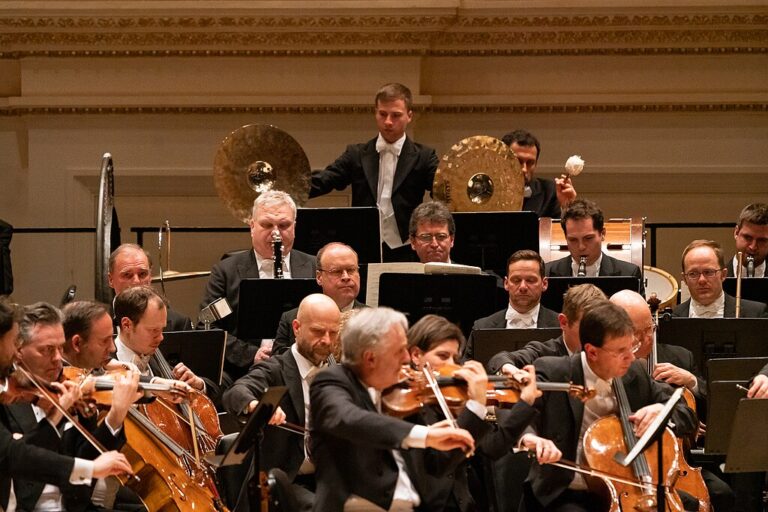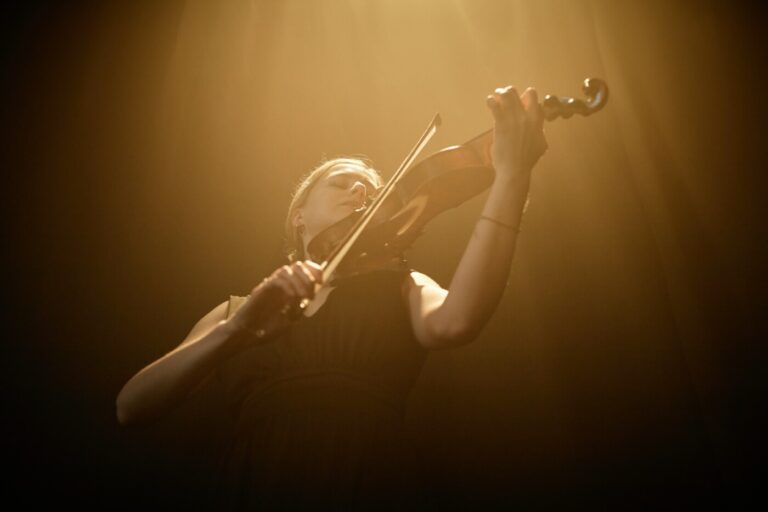Hidden Treasures for the Violin
By Pablo Fayad
In a world where algorithms, playlists, and recommendations shape our tastes, musical beauty often seems reduced to the familiar. Yet, there are still peculiar treasures of beauty hidden in corners we rarely explore. Let us delve into some of these unusual places and create our own list of violin treasures. Let’s think outside the box and discover new pieces through these different topics.
Traditional Music from Around the World for Violin
Of Italian origin and with greater prominence in Western culture, the violin is a well-known instrument in our musical heritage. However, violin music is also present in the works of non-Western cultures. Among them, a Chinese love story.
Butterfly Lovers – He Zhanhao
Zhu Yingtai is a brilliant young woman, daughter of a wealthy family, who dreams of studying. But in an era when women were not allowed into academies, she decides to disguise herself as a man and travels to Hangzhou to attend classes. There she meets Liang Shanbo, a studious young man, and they become inseparable. For three years, they share books, lessons, and a friendship that slowly transforms into love for Zhu. Liang, however, has no idea his best friend is actually a woman.
When the time comes to part ways, Zhu hints at her true identity and invites him to her home, saying she wants to introduce him to her “twin sister” (herself). Liang travels there, but it is too late: Zhu’s parents have already promised her to another man.
What will become of the lovers?
The Butterfly Lovers Violin Concerto (梁祝), composed by He Zhanhao and Chen Gang in 1959, is one of the most moving pieces ever written for solo violin. Based on the tragic love story of Liang Shanbo and Zhu Yingtai—something like a Chinese Romeo and Juliet.
The main melody first appears like a timid butterfly, floating over a delicate tapestry of strings and woodwinds. The violin becomes the voice of Zhu Yingtai, a young woman disguised as a man to study. Her song is sweet, light, almost fearful. As the story unfolds, the instrument becomes filled with passion, pain, struggle, and finally, transformation: the two souls, unable to unite in life, reunite as butterflies beyond the human world.
Other works that come from far away lands:
Raga Bahudari – Brovabarama
Carnatic violin, mixing tradition and improvisation with a musical scale of classical music from southern India.
Violon Taqsim
Palestinian-Lebanese violinist Abbud Abdel ‘Al playing a Violin Taqsim in Maqam Bayati over Iqa’ Sama’i Thaqil (recorded on Lebanese Television)
The Emotions It Awakens
In art, sometimes the most powerful thing is not what is shown, but what is suggested. Just as Giuseppe Sanmartino’s Veiled Christ manages to sculpt marble as if it were translucent fabric draped over a living body, some composers build soundscapes where each note seems covered by a veil of emotion.
This dialogue between the arts—between the visible and the audible—reveals how different disciplines attempt to express the intangible. Music, like sculpture, can suggest more than it shows. Through suspended harmonies, soft timbres, and subtle dynamics, composers invite us to sense depth, as if each sound were a whisper beneath the surface.
On the Nature of Daylight – Max Richter
Max Richter is one of the clearest examples in contemporary music. Works like On the Nature of Daylight or November layer soft strings and slow harmonic progressions to generate an atmosphere of filtered light—a sonic space that doesn’t show everything at once, but suggests deep emotions, just as a veiled sculpture hints at the body or soul beneath the stone.
This concept isn’t exclusive to Richter. Already in the Baroque era, composers like Händel (in Lascia ch’io pianga) or Pergolesi (in his Stabat Mater) sought a similar effect, where music seems to float like a spiritual veil. Later, in the Romantic period, pieces like Chopin’s Nocturnes or Debussy’s Clair de Lune expand this idea, creating harmonic and melodic transparencies that evoke something intimate and ethereal.
Other works that evoke emotional scenes :
Violin Sonata: ii Lent – Jean Huré
A subtle work influenced by impressionism, using ancient modes, suspended harmonies, and contemplative melodic lines
Nocturne for solo violin – Kaija Saariaho
Kaija Saariaho’s Nocturne for solo violin (1994) is a hauntingly delicate, microtonal meditation composed in memory of Witold Lutosławski, exploring timbral nuance and the fragility of sound through sparse, ethereal textures.
Choose a style! Contemporary or Minimalist Music for Violin
Within many styles, we can choose one to explore and discover hidden treasures waiting to be uncovered.
Building on these ideas of subtlety and emotional layering, many contemporary composers explore how minimalism and modern styles reshape our experience of time and texture in music. Minimalist works by Philip Glass, Steve Reich, and Terry Riley use repetition, gradual change, and hypnotic patterns to transform listening into a meditative experience.
The American Four Seasons – Philip Glass
Unlike traditional storytelling, these pieces invite us to inhabit sound structures, where emotion arises gradually through persistent, evolving motifs. For example, Glass’s Violin Concerto No. 2 “The American Four Seasons” reimagines Vivaldi’s classic with an open form that encourages personal interpretation of mood and season.
A pioneer of minimalism, Glass builds his works with rhythmic patterns, relentless arpeggios, and hypnotic progressions. Emotion does not appear suddenly; it emerges—like the changing light in a room over the course of a day. No unnecessary ornaments, just a sonic mechanism that, through persistence, alters our perception of time.
Other works from our modern time:
Near Light – Ólafur Arnalds
Ólafur Arnalds’ Near Light is a contemplative blend of neoclassical piano, ambient textures, and subtle electronic elements, evoking a sense of introspective calm and emotional vulnerability.
Violin Phase – Steve Reich
It’s a seminal work in minimalist music, using phasing techniques: the same melodic pattern is played repeatedly, but gradually shifts out of sync with itself, creating complex rhythmic and harmonic textures. Originally for violin and tape, or four violins, it can also be performed live with looping.
Soundtracks in the Video Game Industry
In video games, music is not just background—it is an invisible actor that defines the scene. Original Soundtracks (OSTs) in this medium have evolved from simple 8-bit melodies to complex orchestral compositions that rival those of cinema. Whether accompanying an epic battle, a lonely landscape, or an intimate story, music in video games does more than follow the action—it transforms it.
Somnus – Yoko Shimomura
Melancholic and luminous at the same time, this piece balances restrained emotion and pure beauty. The violin takes the lead voice in chamber interpretations, revealing a moving sensitivity.
Somnus, the centerpiece of Final Fantasy XV’s soundtrack, composed by Yoko Shimomura, is a piece that transcends the game to become a deep emotional experience. Its title, meaning “sleep” in Latin, invites listeners to immerse themselves in a world where melancholy, hope, and epic storytelling intertwine.
With delicate piano interwoven with gentle orchestral arrangements and a violin caressing the melody with sensitivity and lyricism, Somnus reflects the heart of Final Fantasy XV’s story: the tension between fate and free will, the burden of responsibility, and the strength of human bonds.
Shimomura, renowned for her ability to blend emotion and narrative, achieves in Somnus a perfect balance between intimacy and grandeur, where each note seems to whisper a personal story to the listener. It’s music that doesn’t just accompany—it builds the soul of the game.
Other works that tell a story:
Lightning’s theme/ Blinded by light – Masashi Hamauzu
Blinded by Light, Lightning’s Theme from Final Fantasy XIII, is a dynamic orchestral piece blending driving rhythms, heroic motifs, and virtuosic strings to capture the urgency, strength, and elegance of the protagonist in battle.
Apotheosis – Austin Wintory
Austin Wintory’s Apotheosis from Journey is a soaring, emotionally charged orchestral piece that fuses Eastern and Western musical elements to evoke transcendence, unity, and the climactic ascent of the player’s journey.
Lesser-Explored Musical Genres
Exploring different genres helps broaden our musical tastes and discover new forms of expression. It’s also fascinating to see how instruments like the violin appear in unexpected places, adapting to styles beyond the classical world or what we usually study in class. Have you ever thought about the violin in the universe of mariachi?
Rondinella – Gorgonio Gori Cortés Carrasco
Born in Tonalá, Jalisco, in 1910, Gori Cortés was a virtuoso violinist and Mexican composer whose life was marked by a deep love for music and dedication to his instrument.
His career led him to join important ensembles like the Mexico Symphony Orchestra, conducted by Carlos Chávez, and the Mexico Typical Orchestra, with which he toured internationally.
As a composer, Gori created an extensive body of work spanning popular music, ballads, jazz, and classical music. His most iconic piece, Rondinela, inspired by the flight of swallows over Barra de Navidad, was performed by the Mariachi Vargas and Juan Gabriel, and has been heard around the world—from Japan to the Palacio de Bellas Artes.
Widely honored in his lifetime, Gori Cortés left behind a heartfelt legacy where the violin sings with a Mexican accent. His music, deeply lyrical and evocative, deserves to be rediscovered as one of Mexico’s great violin treasures.
Other works that come from our roots:
Fuga Y Misterio – Astor Piazzolla
Fuga y Misterio by Astor Piazzolla is a vibrant fusion of Baroque counterpoint and Argentine tango, where a driving fugue explodes into the raw passion and rhythmic intensity of nuevo tango, capturing both intellect and emotion in a single breath.
Honeysuckle Rose – Tomas Waller (Interpreted by Stéphane Grappelli)
Grappelli’s version of Honeysuckle Rose is a celebrated interpretation and improvisation of this jazz standard, bringing his unique violin voice to a well-known classic.
Conclusion
We’ve only begun to uncover a handful of these hidden violin treasures—whether they come from distant cultures, unexpected genres, or unique artistic intersections. The violin’s voice stretches far beyond the familiar concert halls and playlists, waiting patiently in corners we seldom explore. Each soundscape, each style, offers a new story, a new world to discover. What hidden violin gems have you found along your own musical journey? We’d love for you to share them and continue expanding this ever-growing tapestry of sound.
Bibliography
- Butterfly Lovers’ Violin Concerto. (s.f.). Wikipedia. Recuperado el 2 de agosto de 2025, de https://en.wikipedia.org/wiki/Butterfly_Lovers%27_Violin_Concerto
- Violin.es. (2020, 30 de octubre). Obras para violín poco conocidas. https://violin.es/2020/10/30/obras-violin-no-conocidas/
- Mármoles Barbeito. (s.f.). Cuando el mármol se hace tela. https://marmolesbarbeito.com/cuando-el-marmol-se-hace-tela/#:~:text=Fue%20el%20material%20favorito%20de,todas%20las%20biograf%C3%ADas%20del%20escultor.
- MasterClass. (s.f.). Minimalism music guide: An introduction to minimalist music. https://www.masterclass.com/articles/minimalism-music-guide
- Sociedad de Autores y Compositores de México (SACM). (s.f.). Biografía: Gorgonio Cortés Carrasco. https://sacm.org.mx/Informa/Biografia/08520
- SACM – Sociedad de Autores y Compositores de México. (s.f.). Premios y reconocimientos a músicos mexicanos. https://www.sacm.org.mx/
- Maqam World. (n.d.). Violin. Retrieved August 2, 2025, from https://www.maqamworld.com/en/instr/violin.php
- Johnson String Instrument. (n.d.). Violin in world music. Retrieved August 2, 2025, from https://www.johnsonstring.com/resources/violin-in-world-music/?srsltid=AfmBOor27d7lChHa8edtb67yukwWN0bOx9uXCTZ1lKcc3OjY3uHHBjfW
- Wikipedia. (fecha de última edición no disponible). Yōko Shimomura. Wikipedia. Recuperado el 7 de agosto de 2025, de https://es.wikipedia.org/wiki/Y%C5%8Dko_Shimomura
- Honeysuckle Rose (song). (n.d.). In Wikipedia. Retrieved August 7, 2025, from https://en.wikipedia.org/wiki/Honeysuckle_Rose_(song)



